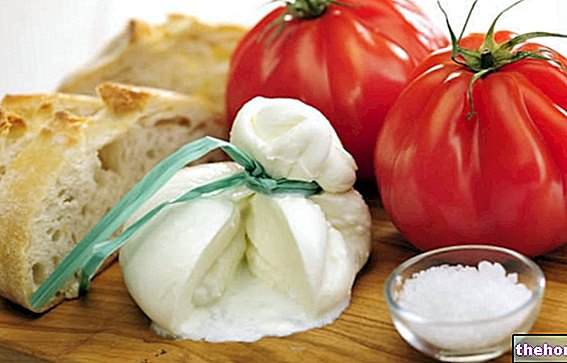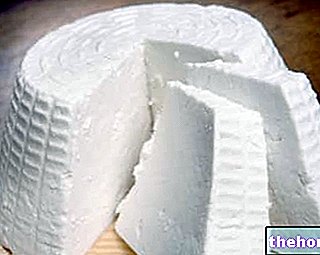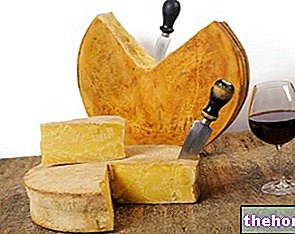Generality
Tomino (sometimes synonymous with “robiolino” or “goat's milk from cow's milk”) is a typical north-Italian cheese, characteristic of the Piedmont region.
It is a product of animal origin which is part of the whole of dairy products, which in turn are contextualized in the II fundamental group of foods.
The dietary function of tomino and these foods is to provide proteins, fats, some vitamins and quite specific minerals.

To tell the truth, the name “tomino”, rather than a specific cheese, refers to a heterogeneous group of foods characterized by a flattened, circular and small size.
Tomini are fresh, seasoned, in oil, spiced, etc. They can be soft, compact but without rind or with a flowery rind.
The best known tomino is the one with a flowery rind, therefore provided with a light surface coating induced by molds similar to those of brie.
Nutritional Properties
ATTENTION! The following corresponds to the average of the values calculated for the tomino robiolino and the flowered rind.
Tomino provides an average of 50-60% of water, 20-27% of fats, 15-20% of protein substances and 4-5% of mineral salts.
Tomino is a food that can be useful in the diet of the healthy and normal-weight subject, but it is not recommended in the diet of those suffering from overweight and / or metabolic alterations.
Tomino contains significant amounts of high biological value proteins, calcium, phosphorus, vitamin A, vitamin B2 (riboflavin) and vitamin B12 (cobalamin). These characteristics make it a useful product in the nutrition of the growing subject and of those who intend to prevent bone rarefaction (osteoporosis in old age, especially in women entering menopause).
On the other hand, the high caloric density, provided mainly by lipids, excludes its frequent use and / or in significant portions for people who should reduce "caloric intake for weight loss.
The cholesterol share, as well as the percentage of saturated fat, is not negligible and makes Tomino a food unsuitable for the diet against hypercholesterolemia.
Among other things, tomino has moderate levels of sodium, an element which, if in excess, becomes unfavorable for those affected (or at risk) of primary arterial hypertension.
Last but not least, the recommendation to avoid the intake of flower rind tomino in case of pregnancy; the advice comes from the awareness that these products can be contaminated by Listeria monocytogenes, a microorganism harmful to the health of the fetus.
The average portion of tomino cheese is about 70-80g for the flowery crust and 100-120g for the robiolino.
Characteristics of the cheese
Tomini are cheeses made from cow's or mixed milk; some types are in fact produced thanks to the mixture of cow, sheep and goat.
Tomins are usually obtained by slow rennet coagulation (ie thanks to the use of rennet) or acid-rennet (rennet and lactic acid of microorganisms); an equally long-lasting purging follows.
The shape is always small, cylindrical or prismatic; however, by virtue of the considerable heterogeneity that distinguishes these cheeses, it is not possible to create a "single description that applies to all tomini.
From a product point of view, Tomino "robiolino" (fresh cheese, sometimes soft) should have the following chemical characteristics:
Element
Amount
Waterfall
60g
Lactose
2g
Fat on as it is
20g
Total protein
14.7g
Mineral salts
2.5g
Dry substance
40g
Fat on dry matter
50g
Power
247kcal
Proteins
Whey proteins
0.5g
Casein
14.2g
Mineral salts
Football
400mg
Phosphorus
300mg
Sodium chloride
1000mg
Indices and reports
Maturation method index
10
Index method of lipolysis
2
Fat / protein ratio
1,37
Source: Atlas of Cheeses - Hoepli - Giorgio Ottogalli
Tomino “robiolino” has no rind, has a soft texture and, depending on the specific type, sometimes has a spreadable consistency. It requires storage at low temperatures and, like other fresh cheeses, in the refrigerator it can reach a shelf-life limited to a few days. However, hermetically sealed in plastic bags with preserving liquid, some tomini can be stored for 10-15 days. A longer duration can be obtained by means of other treatments (thermal in heat or in oil).
The “tomino” with flowery rind also has a soft and fluffy internal paste, however enclosed by a thin white casing; the latter is suitably colonized by a fungal mycelium microflora, with soft, dry and powdery spores. It matures for about 15-30 days, never more than 45 days. It can be stored for more than 15 days but does not require any sealing. . In fact, the tomino with flowery rind (as well as brie), has no preserving liquid and needs to "breathe", since conservation is guaranteed by the molds that cover it. However, the increase in duration corresponds to a reduction in the content. in cheese water.
The “robiolino” tomino can be eaten fresh in salads, or cooked in the sauces of first courses, in the fillings of stuffed pasta and on bruschetta. The flower-crusted tomino can be eaten raw, sometimes with liquid honey and / or dried fruit (such as walnuts), or grilled or grilled in combination with cold cuts such as speck; the tomini are suitable for accompanying light white or rosé wines.
Milk, Dairy Products and Cheeses Asiago Brie Burrata Caciocavallo Rennet Camembert Cheddar Milk Cream Crescenza Emmental Feta Milk Flakes Fontina Herbal Cheeses Lean Cheeses Cheeses rich in calcium Gorgonzola Gouda Grana Padano Gruyere Kéfalair Adapted milk Artificial milk Condensed milk Asphyxiated milk Goat's milk Sheep's milk Rice milk Soy milk Powdered milk and concentrated milk Skimmed and semi-skimmed milk Lactose-free milk Milk Vegetable milk Dairy products Lerdammer Mascarpone Montasio Buffalo mozzarella Mozzarella Whipped cream Cooking cream Fresh cream Parmigiano Reggiano Pecorino Philadelphia Primo Sale Provolone Ricotta Robiola Roquefort Scamorza Sottilette Squacquerone Taleggio Tomino Yogurt OTHER ARTICLES MILK AND DERIVATIVES Categories Alcoholic foods Meat Cereals and derivatives Sweeteners Sweets Offal Fruit Dried fruit Milk and derivatives Legumes Oils and fats Fish and fishery products Cold cuts S pezie Vegetables Health recipes Appetizers Bread, Pizza and Brioche First courses Second courses Vegetables and Salads Sweets and Desserts Ice creams and sorbets Syrups, liqueurs and grappa Basic preparations ---- In the kitchen with leftovers Carnival recipes Christmas recipes Light diet recipes Women's Day, Mum, Dad Recipes Functional Recipes International Recipes Easter Recipes Recipes for Celiacs Recipes for Diabetics Recipes for Holidays Recipes for Valentine's Day Recipes for Vegetarians Protein Recipes Regional Recipes Vegan Recipes




























